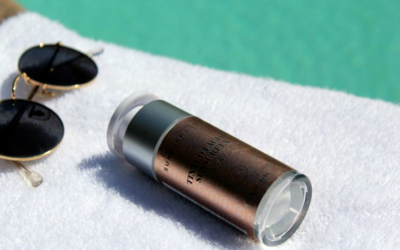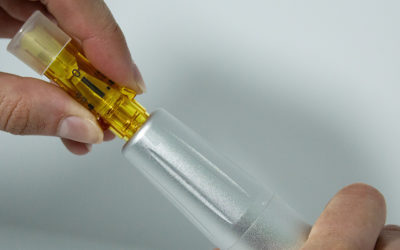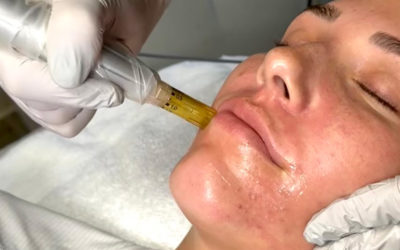How Delivery Systems Change Skincare Effectiveness Marc A. Ronert MD PhD
Last updated on May 16th, 2022
 The skin is the largest organ of the human body and makes up about 15%—roughly seven pounds—of body weight. Its complex, water-resistant structure fulfills numerous protective functions against environmental exposures, such as UV radiation and other harmful toxins; as well as chemical, microbial and physical influences.
The skin is the largest organ of the human body and makes up about 15%—roughly seven pounds—of body weight. Its complex, water-resistant structure fulfills numerous protective functions against environmental exposures, such as UV radiation and other harmful toxins; as well as chemical, microbial and physical influences.

The nature of the skin’s anatomy limits permeability, which is advantageous as a defense mechanism, but presents a challenge in delivering ingredients into the skin. Topical or transdermal delivery of ingredients are heavily researched for drug applications in the pharmaceutical world, and there are connections and beneficial clinical findings that can be translated for the cosmetic skin care industry, as well. Delivery mechanisms and physiological conditions are identical for both drug and cosmetic ingredients. Therefore, several methods have been examined on how to increase the effectiveness of active ingredients for the skin, and how to overcome the protective barrier, making active ingredients more effective to positively enhance a desired result.
The structure of the skin
Simply put, the skin consists of four main layers:
~The outermost layer, or the stratum corneum (SC);
~The viable epidermis (living tissue);
~The deeper dermal layer; and
~The subcutaneous connective tissue.
The stratum corneum consists of a strong layer of dead skin cells comprised of dehydrated keratinocytes that are embedded in lipid layers. In order to reach living tissue, this protective cover and barrier needs to be passed by active ingredients. Skin care products using active ingredients that cannot pass this barrier can have moisturizing and protective functions, but they cannot affect the living tissue and, therefore, cannot alter or positively influence living cells to achieve a longer-lasting result. How good is an ingredient or product, really, if it can’t reach the area it is intended to reach?
As a physician, I often hear the question: “What types of delivery systems are used in order to get ingredients to the spot where they actually can do what they are meant to do?”
The factors of functionality
That simple question is extremely complex. There are numerous factors and mechanisms that can promote the delivery of ingredients. The term “delivery system,” as it is used in the skin care industry, refers to the definition or mechanism for how active ingredients reach the deeper layers of the skin in order to fulfill their function at a target site.
There are three mechanisms active ingredients can use to help them reach live tissue.
Intercellular. These active ingredients travel in between keratinocytes into deeper layers.
Transcellular. This means that active ingredients must penetrate from cell to cell in order to reach deeper.
Transappendageal. This means other openings, such as sweat glands, sebaceous glands or hair follicles, are used as travel pathways to reach lower levels of the skin.
The pathway that specific active ingredients can utilize depends on many factors that are closely interconnected.
Concentration. One of the major factors in a good delivery system is the concentration of active ingredients. The higher the concentration of a particular ingredient, the more the skin will try to absorb it, leading to more of the active ingredient ultimately being relocated into the deeper layers of the skin.
pH. Although the concentration is important, it is also influenced by the pH. pH alone is a great delivery system, because the skin is always attempting to neutralize pH differences and stay in a pH-balanced state. The lower the pH, the more product will travel into deeper layers, because the skin is trying to balance and increase the pH again to a higher level. The higher the pH of a particular product, the less the active ingredients will penetrate the skin; instead, they will sit on the surface.
The best examples of this phenomenon are chemical peels, which depend greatly on pH. Low pH peels will be stronger and more effective than peels with a higher pH, even if they have the same concentration of active ingredients. Therefore, all peels are not created equal just based on the percentages of the acids included.
Molecular size and weight. The molecular size of the active ingredient also plays a crucial role in the effectiveness of skin care products. If the molecules of ingredients used are too large to penetrate the skin, the product will simply linger on the skin’s surface. If a product is not properly absorbed, it can lead to irritation, sensitization, breakouts, skin dehydration, increased skin problems and other complications, or just not deliver the results claimed. Molecules under 500 daltons (kDA)—the measurement of molecular weight—can penetrate the skin, while ingredients that are above this threshold will not pass through if not altered structurally, or attached to other ingredients or methods that will allow these ingredients to be pulled into the skin.
Nanotechnology. Nanotechnology is relatively new to the cosmetic and skin care world. It gained popularity when sunscreen ingredients zinc oxide and titanium dioxide were made available in nano-sized forms in order to spread better and have an enhanced cosmetic application. Nanotechnology for skin care refers to the method of delivering a molecule into skin at a very small size. A nanoparticle is any material measuring less than 100 nanometers (nm) in at least one dimension. Because they are extremely small particles, they travel deeper into skin, can be applied more evenly and spread easily. Even though several studies have deemed nanoparticles safe to use, there is some controversy surrounding this technology. Because the particles are so tiny, there is fear that they could potentially be absorbed systemically, and then be present in other organs or locations than those desired.1 Some experts speculate that the active ingredients in nanoparticles may reach the bloodstream due to their ability to cross cell membranes, even though more recent studies have confirmed that the content of these ingredients reaching the bloodstream is negligible.1 In the meantime, the U.S. Food and Drug Administration (FDA) has issued statements calling for continued, appropriate testing,2 and the skin care industry is cautious about using these types of ingredients before more clinical data is available.
Another option is to use micro- or fine particle-sized ingredients that are above the 100 nm definition, but are still smaller than regular molecules of their original ingredient to offer an enhanced cosmetic application. These micro-fine particles are utilized in sunscreen preparations to enhance the feel of the application, as well as its effectiveness.
Characteristics of ingredients. Whether a substance is water-soluble (hydrophil) or lipid-soluble (hydrophob) also influences the amount that can be absorbed through the skin. As an example, a newer type of lipid-soluble vitamin C showed an enhanced penetration rate into skin from the original form of water-soluble vitamin C. Still, it would not be safe to say that lipid-soluble ingredients travel deeper into skin than water-soluble ingredients, since many aforementioned factors play a vital role to the extent in which these ingredients will be delivered.
Innovative vehicles
Nowadays, skin care products can utilize innovative and unique vehicle molecules that can transport active ingredients into skin. One of the first structures to be studied as an effective delivery system for the skin are so-called phospholipids. Phospolipids are structures with two different endings: a lipid-soluble end and a water-soluble end. These ends can attach to the original active ingredient. The active ingredient-loaded phospolipids can then travel to deeper layers of the skin, releasing the active ingredient on its way. Multiple bilayers of these phopholipids can form liposomes—small vesicles filled with content—that contain active ingredients, which can then slowly release into the skin throughout time.
Many of the new types of active ingredients, such as plant-derived stem cells, are now offered in a dispersion of liposomes to enhance skin penetration and, therefore, the effect. Also, because of the growing competitiveness among skin care companies, some brands are creating their own delivery system technology that is unique to their product line.
External devices
Use of external devices may also increase the efficacy of product penetration.
Ultrasound/microdermabrasion. One method that is fairly new utilizes ultrasound technology. Ultrasonic treatment can be performed by itself or in conjunction with a microdermabrasion treatment. When used with microdermabrasion, the absorption rate of topical vitamin-enriched products may increase.
High frequency. High frequency is another method for increasing the absorption of products into the skin. High frequency involves the use of a current to aid in product penetration and gentle skin stimulation. It benefits the skin by helping in the penetration of treatment creams, serums and complexes by increasing the blood flow in certain areas, and regenerating and re-energizing tired, stressed skin.
Galvanic. Another less frequently used but effective tactic involves galvanic current. Using galvanic current on the positive polarity is referred to as iontophoresis. During an iontophoresis treatment, a low electrical current is applied to the skin, which provides the driving force to enable the penetration of charged molecules deep into the skin. It is ideal for aging skin in helping to carry active, age-fighting ingredients deeper into the skin.
Enhance efficacy and future sales
It’s important to have a fundamental knowledge of the delivery systems employed in the skin care products you work with to ensure their effectiveness. If you’re not sure, most reputable companies have an educational team that handles these types of inquiries.
Using a delivery system creates a superior product that penetrates more effectively and feels better on the skin. All of these attributes are influential on consumer behavior and repeat spending patterns, based on the success and affect clients will have with that specific product. Products with delivery systems to boost the actives penetrate more deeply, thereby providing enhanced efficacy, and generating increased product performance and future sales.
REFERENCES
www.beautymagonline.com/sample-pages/1190-nanotechnology-2
www.fda.gov/Cosmetics/GuidanceRegulation/GuidanceDocuments/ucm300886.htm
Marc A. Ronert, MD, PhD, president and medical director of Image Skincare, is a European board-certified plastic, reconstructive and aesthetic surgeon, as well as a diplomat of the European Board of Plastic, Reconstructive and Aesthetic Surgeons. He is also the founder and president of the Care for Skin Foundation, which supports people in need of plastic reconstructive surgery.
Find certified Dermapen microneedling professionals
Dermapen® Microneedling Devices are exclusively sold to Medical and Skin Care Professionals. Use the form to the right to get started finding a Certified Dermapen® practitioner in your area.
Enter your location information to find a Dermapen Skin Care Professional.
Want to become a Dermapen Practitioner?
Medical Clinics and Spas can offer their patients the worlds most advanced microneedling treatments with Dermapen
Microneedling Treatments
The Dermapen Microneedling Pen provides an unparalleled response through the segmented delivery of microneedles, creating micro injuries to the epidermis (outer layer of skin) and dermis (the inner layer of skin). As a result, the micro injuries encourage the body’s innate ability to repair itself.
Every Dermapen tip is outfitted with 12 needles and features our patented technologies, which include SureSpace™ and SafLok™. Accordingly, these safety enhancements can be found in every Dermapen needle tip and pen.
Furthermore, by using SureSpace™ and SafLok™ microneedling pen technologies, practitioners can deliver their patients the safest microneedling treatment possible, while getting the best microneedling results for their patients.



